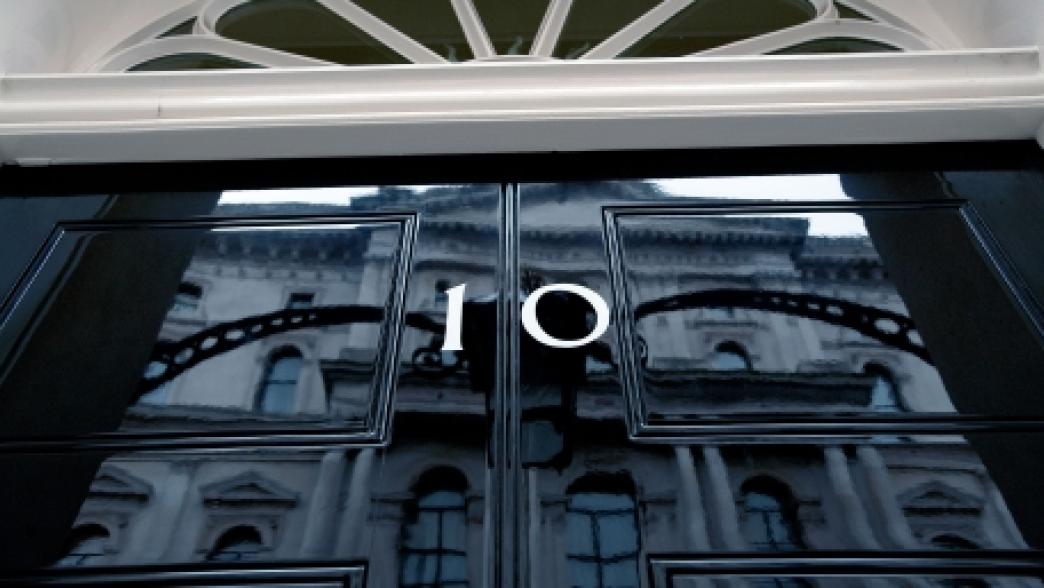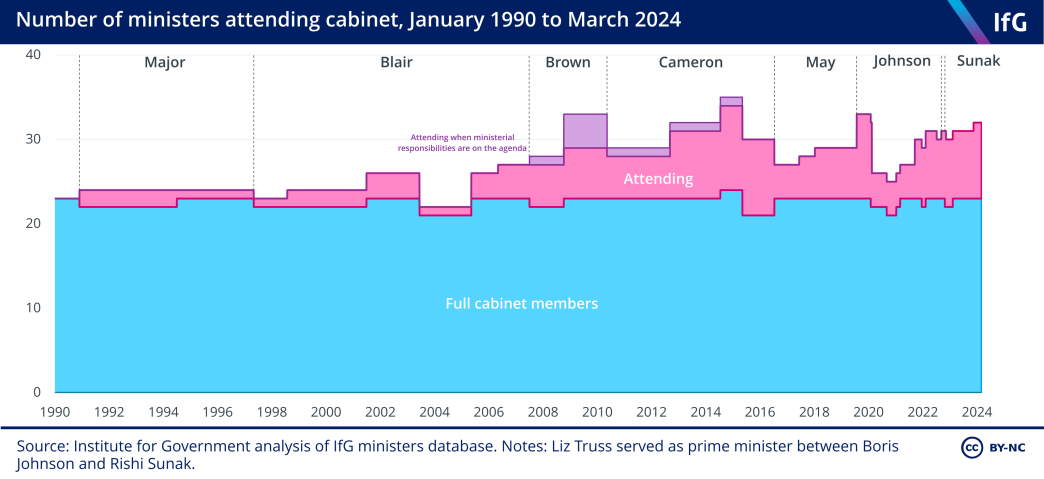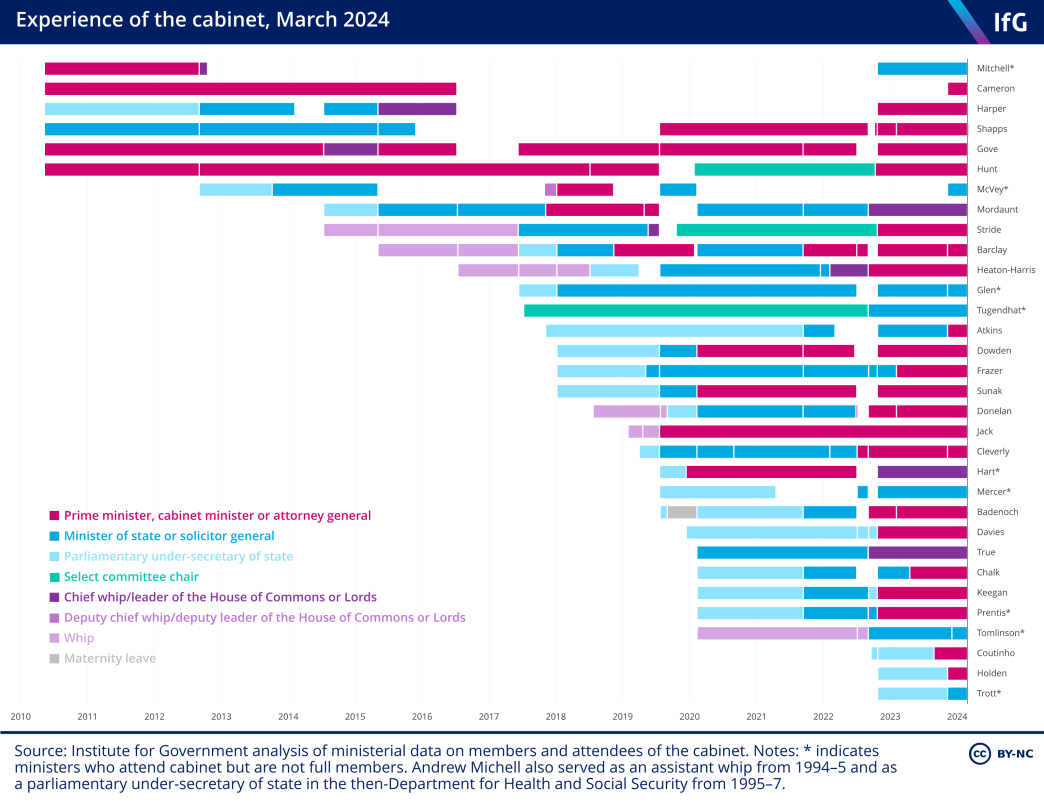Cabinet
The cabinet is the senior decision-making body in government.

What is the cabinet?
The cabinet is the senior decision-making body in government. As described by the Cabinet Manual, the cabinet is "the ultimate arbiter of all government policy" and "decisions made at cabinet and cabinet committee level are binding on all members of the government."
The cabinet is chaired by the prime minister and comprises the most senior ministers in government. Formally, it is the cabinet that governs the UK – although the role of the prime minister within the cabinet gives him or her particular powers over the decisions made by the cabinet.
The term ‘cabinet’ also refers to the meetings of the cabinet, as well as the body itself.
Who is in the cabinet?
The cabinet consists of the prime minister, the chancellor of the exchequer and all secretaries of state (the most senior minister in each government department).
Rishi Sunak's cabinet also includes minister without portfolio and chairman of the Conservative party Richard Holden.
Some junior ministers also attend cabinet but are not full members. Currently these are:
- Simon Hart, chief whip
- Laura Trott, chief secretary to the Treasury
- Victoria Prentis, attorney general
- John Glen, paymaster general and minister for the cabinet office
- Esther McVey, minister without portfolio
- Michael Tomlinson, minister for illegal migration
- Tom Tugendhat, security minister
- Andrew Mitchell, development minister
- Johnny Mercer, minister for veterans' affairs
The number of junior ministers attending cabinet has fluctuated considerably in recent years. After taking office in 2019, Boris Johnson invited 10 junior ministers to attend cabinet, before drastically reducing this number to four in 2020. When Liz Truss became prime minister in September 2022, she appointed eight junior ministers who would attend cabinet. This number briefly increased to nine for the first weeks of Rishi Sunak’s term as Prime Minister, returned to eight with the resignation of Gavin Williamson, and increased again to nine with appointment of Esther McVey in November 2023.

The experience of cabinet ministers can vary significantly. Several members of Rishi Sunak’s cabinet served as secretaries of state under Liz Truss, including business secretary Kemi Badenoch. Scotland secretary Alister Jack is the only member of the cabinet to have served continuously since the last general election. No minister has been a member of cabinet continuously since Theresa May's period in office.
Some ministers are fairly new to cabinet, such as the health secretary, Victoria Atkins, whose previous ministerial experience was as a junior minister in the Home Office, Ministry of Justice and the Treasury. Richard Holden, minister without portfolio and Conservative party chair, was previously a parliamentary under-secretary of state in the Department for Transport.

During cabinet meetings, civil servants from the cabinet secretariat attend to take minutes of the meeting and record any decisions. Some political advisers also attend, on the approval of the prime minister. However, neither officials nor political advisers take part in discussions.
When and where does the cabinet meet?
The cabinet meets once a week when parliament is sitting. In most cases meetings take place in the cabinet room in 10 Downing Street.
Occasionally the cabinet may meet in other locations around the country. On 31 January 2020, it met in Sunderland to mark the UK’s departure from the EU.
For much of the coronavirus pandemic, the cabinet met remotely, using video-conferencing technology.
How does the cabinet make decisions?
The cabinet is supposed to be a space for private, frank discussion of issues. Ministers are allowed to disagree with each other. But once a position has been agreed, all ministers are expected to abide by that position or resign from office. This is known as collective responsibility. Some cabinet discussions are leaked to the press, but prime ministers often try to clamp down on this. When Boris Johnson became prime minister he issued a new edition of the ministerial code which stated clearly that ‘there must be…no leaking’.
Generally the minister responsible for a particular issue will introduce it to the cabinet before an open discussion takes place, with each minister putting forward their views on the topic in hand. The chair of a cabinet meeting – generally the prime minister – will summarise the discussion and any decisions, which will be minuted by the officials present and circulated to all ministers.
Some issues do not require the approval of all members of cabinet, as they are seen as less significant but still require agreement from multiple ministers. However, there is no definitive list of what issues require agreement at full cabinet. Issues that do not require agreement of the full cabinet may be discussed in a cabinet committee. These are groupings of specific ministers who discuss a particular subset of issues. Under the terms of collective responsibility, decisions taken in cabinet committee are nonetheless binding on all government ministers.
Many issues that require a decision in cabinet or in a cabinet committee are not actually discussed in a meeting. Instead, the ‘write-round’ process is used. The minister requesting a decision will write to all the members of the relevant committee and ask colleagues to agree with his or her proposal. If ministers do not agree to the proposed decision, they can write to the chair of the committee to explain their position. The cabinet secretariat may help broker an agreement if ministers disagree. If an issue cannot be resolved through writing, a meeting may be called to find a solution.
Is the cabinet an effective decision-making body?
Different ministers have different views on the effectiveness of cabinet. There is a general view that it rubber stamps decisions already made by key ministers, rather than being a forum for real discussion. But this can depend on the approach of the prime minister running the discussion. Jeremy Hunt, who served as a cabinet minister under both David Cameron and Theresa May, said that:
“Theresa May would often have a cabinet meeting where we didn’t know what she believed. In a way, that made the cabinet meetings more interesting because you thought that maybe what you were saying might have weight attached to it. Whereas in David Cameron’s cabinet meetings, after George Osborne had spoken, you basically knew what David Cameron and George Osborne thought and the matter was broadly over.”
Under Tony Blair, the cabinet was often seen as a simple rubber stamp for decisions made by the prime minister and his advisers; this approach to government has been referred to as “sofa government.”
Under previous administrations, the cabinet was the scene of greater discussion and disagreement. Michael Heseltine famously resigned as defence secretary in the middle of a cabinet meeting in early 1986 during the Westland affair.
The size of the cabinet can also make in depth discussion and considered decision making difficult. And while the prime minister is in charge of summarising decisions made in cabinet, it is other ministers who are generally in charge of implementing those decisions – they have the legal and financial powers to do so. Ultimately a decision being made in cabinet does not guarantee that anything will change in the real world.
What is the political cabinet?
The political cabinet is a meeting of ministers – and sometimes other politicians from the governing party – that is held to discuss political matters. The meeting may take place in the Cabinet Room in Downing Street as usual, but no officials will attend and the discussion will not be minuted. The political cabinet meets when the prime minister feels it is appropriate.
What is the shadow cabinet?
The shadow cabinet is the grouping of senior figures in the official opposition party (currently Labour) who ‘shadow’ current secretaries of state. They are responsible for scrutinising the work of current ministers and asking questions of them in parliament. The shadow cabinet meets at the discretion of the leader of the opposition, and it is an opportunity for the opposition to agree policy positions.
Shadow cabinet positions mirror those in the actual cabinet. But if the opposition party becomes the governing party after an election, there is no requirement for the leader to appoint his or her colleagues to the ministerial roles they were previously shadowing.